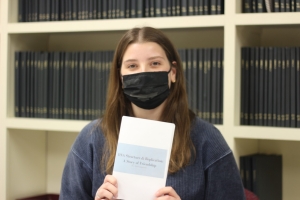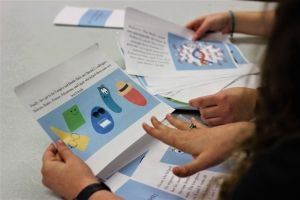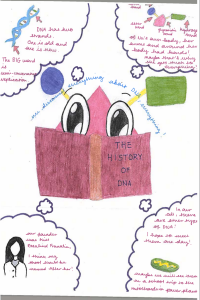Genetics Through the Looking Glass: How One Biology Professor Weaves Together Science and Storytelling

Ava Giaquinto, CLAS ‘23, showcasing her storybook.
University-required science courses: some students may view them as an opportunity to flex their analytical prowess, while for others, simply uttering the word “lab ” may cause nervousness. Christina Winterton, PhD, assistant teaching professor of Biology, understands this better than most. And her Mendel Science Experience course, Heredity & Human Affairs, adds a welcome flair to the study of genetics.
But fear not. This isn’t your grandmother’s biology class.
For Villanovans, MSE is a classification of thematic science courses required by the University to encourage scientific literacy in non-science majors within the College of Liberal Arts and Sciences. And throughout Heredity & Human Affairs, students focus on the social/ethical impacts of genetics, including but not limited to: genetic engineering, assisted reproduction, artificial wombs, cloning, fetal stem cells and gene therapy. Timely, engaging, and inclusive, the course aims to bring all Villanova community members together – regardless of the degree they are working toward.
“I love working with non-majors,” says Winterton, who focused on making the course interdisciplinary. “In the first month, we hit the science topics pretty hard: meiosis, fertilization, DNA replication. These are the things that you need to know so that in the second half of the semester, we can do more applications. We look at behavior, immunity, cancer, ethics, genetically modified organisms. And we get more into social aspects. But the students are able to have these very informed discussions because they’ve already had that solid foundation.”

Ava Giaquinto's DNA replication storybook.
Ava Giaquinto, '23 CLAS, took the course during the Fall 2021 semester and is a testament to Winterton’s teaching philosophy. “I am a transfer student. Last semester was my first time at Villanova” says Giaquinto. “The program I was doing at my previous school was very communication-focused and I wanted that liberal arts opportunity. This course hit the mark. It’s for non-majors, but you’re going to learn the biology. In class, the conversation just lit up.”
And in a class with such academic variety, Winterton decided that students should complete their midterm assessment in a way that emphasized each individual's strengths. For that, she gave students choices, one of which was to write and publish a storybook. “I’ve never offered this before in any form of my teaching and I wasn’t sure anyone would choose this option. 13 out of 18 students chose this.”
“The idea behind the storybook was, what’s a fun way that students can show me that they learned the point and show me the foundations? How can I get them to show me they know what’s happening and what’s important? What better way to tell if someone knows something than to have them teach or explain it? And what is a more fun way to teach or explain something than to put it in a children’s storybook?” The rules of the assignment were simple – take one of the complicated topics discussed in class and break it down to the nuts and bolts in the form of a children’s story.

Laurel Lancaster's history of DNA storybook.
Giaquinto loved the assignment. “I knew I wanted to do the storybook because I was able to be creative in designing the graphics. I chose DNA structure replication because to me, it was the most narrative in my head. When we were learning about it in lecture, I was like, oh this tells a story. By the time I finished writing it, I realized I really did know the science as much as I knew how to tell a story.” And that’s exactly what Winterton hoped for. “They did amazing. Ava’s in particular I was amazed with. She went above and beyond what the assignment asked for.”
Laurel Lancaster, '24 CLAS, another of Winterton’s students, wrote and illustrated a creative and detailed story about the history of DNA, its structure, and its function. Readers follow a DNA molecule named "Nu" (as in nucleotide and nucleic acid) as the molecule uses different resources to find out what Nu is made of and what her purpose is. “The time and effort put into this project was so clear, and it stuck out to me because DNA and the history behind all the experiments were the first topics we covered in class,” said Winterton.
When asked what Winterton hoped her students walked away from her course with, she said, “I hope they see parts of our conversations just in their everyday interests. I just love to hear there’s an interest in the science, even though it’s not their major and not something they thought they liked before coming into the class. Seeing a new passion and excitement in the students is really cool.”
And Winterton, with grace, appreciation, and passion for her craft, continues to provide students with the tools to do just that.
